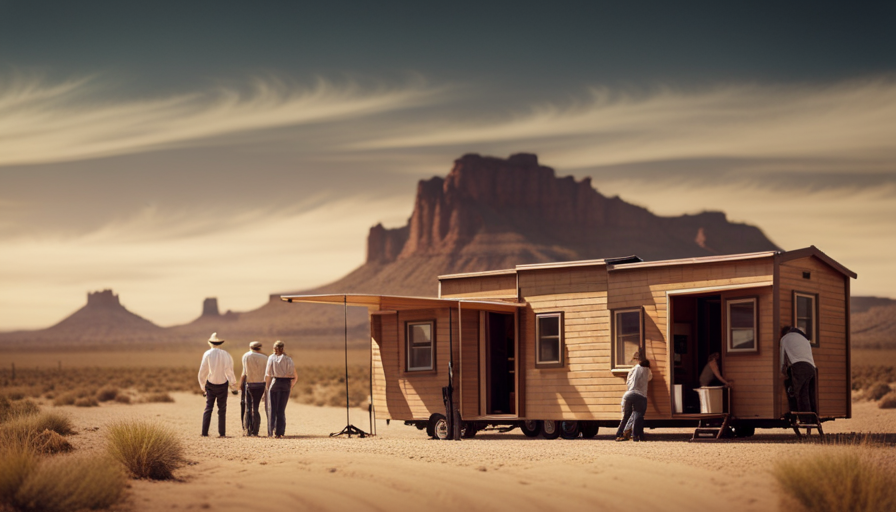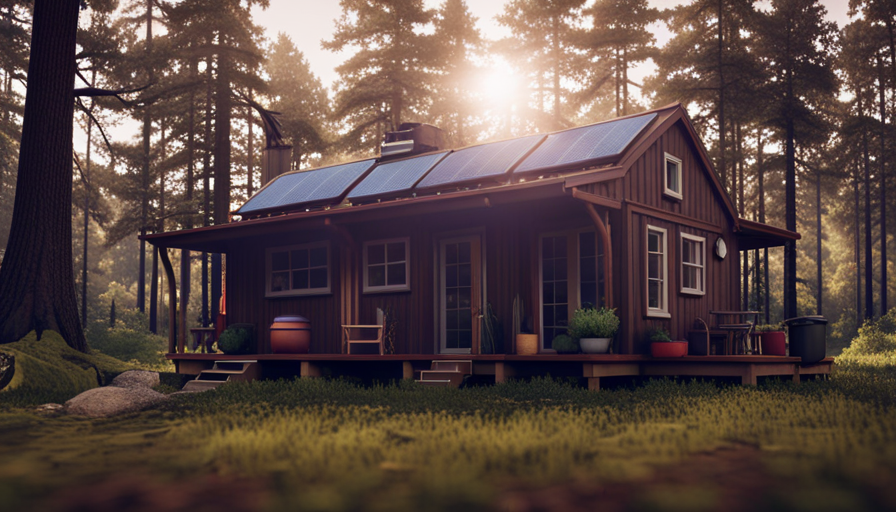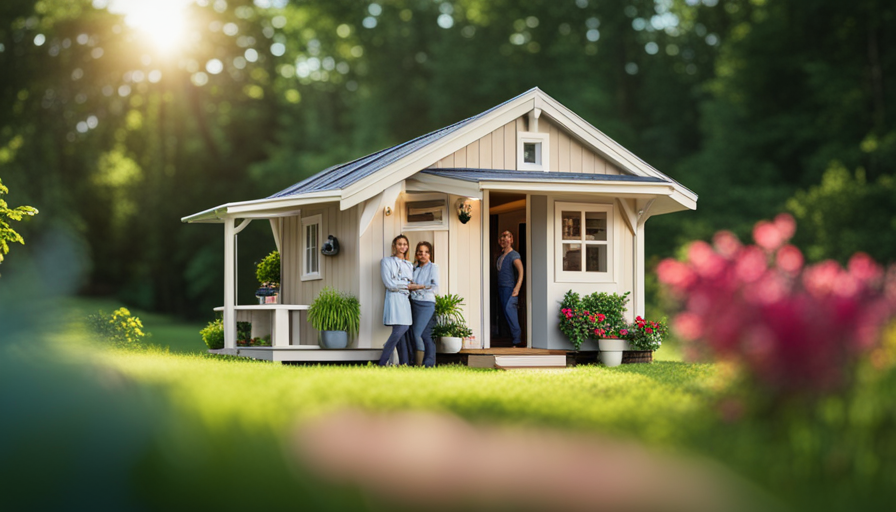As I stroll down the street, I can’t help but notice the wide variety of houses lining the roadside. From lavish estates to quaint small homes, there is something to suit every taste and lifestyle. However, I have found myself particularly intrigued by the increasing trend and appeal of two unique housing options: tiny houses and mobile homes.
At first glance, they may seem similar, but upon closer inspection, their differences become apparent. In this article, I will explore the unique characteristics of these two housing options and shed light on the factors that set them apart. From size and mobility to construction and customization, there is much to consider when choosing between a tiny house and a mobile home.
So, let us delve into the details and discover the pros and cons of each, ultimately helping you make an informed decision about which option is right for you.
Key Takeaways
- Tiny houses are small, compact homes that encourage minimalism and offer more opportunities for customization, while mobile homes are larger and have more space for larger families.
- Tiny houses are built on a trailer chassis and are subject to the same regulations as traditional homes, while mobile homes require special permits and equipment for transport and are regulated by HUD.
- Tiny houses foster a sense of community and promote a sustainable lifestyle, while mobile homes are often located in mobile home parks with amenities and a sense of community.
- Tiny houses are more affordable than traditional homes or mobile homes, but may face zoning challenges, have limited storage space, and may not be suitable for larger families. Mobile homes, on the other hand, can be more expensive to repair and may not appreciate in value over time.
Size Comparison
Tiny houses may be small, but they pack a big punch when it comes to maximizing space and creating a cozy atmosphere. Compared to mobile homes, tiny houses offer several benefits.
One of the most significant advantages is their size. Tiny houses are typically around 100 to 400 square feet, whereas mobile homes can range from 500 to 2,500 square feet. This smaller size allows for efficient use of space and encourages minimalism. With clever design and storage solutions, tiny houses can accommodate all the necessary amenities while still feeling spacious.
On the other hand, mobile homes often come with some disadvantages. Their larger size means more maintenance and higher utility costs. Additionally, mobile homes can be more challenging to transport and require special permits and equipment.
Tiny houses, on the other hand, are built on a trailer chassis, making them easily movable. This mobility allows tiny house owners to change locations easily, whether it’s for work, travel, or simply a change of scenery.
Transitioning to the next section about mobility and portability, it’s important to note that tiny houses offer the advantage of being able to travel while maintaining a cozy and comfortable living space.
Mobility and Portability
When it comes to mobility and portability, you’ll find that a tiny house is like a snail’s shell, while a mobile home is more like a turtle’s shell. The tiny house movement has gained popularity in recent years, with more and more people opting for a simpler and more sustainable lifestyle.
Tiny houses are typically built on wheels, allowing them to be easily transported from one location to another. They are designed to be lightweight and compact, making them ideal for those who want the freedom to move around and explore different areas.
On the other hand, mobile homes are larger and often require a special permit to be moved. They are typically located in mobile home parks, where residents can enjoy the amenities and sense of community that come with living in a designated mobile home community.
Transitioning to the next section about construction and building codes, it’s important to understand the differences in regulations and requirements for these two types of housing.
Construction and Building Codes
If you’re considering building a compact dwelling, it’s essential to familiarize yourself with the construction and building codes that apply to your chosen type of housing. When it comes to tiny houses and mobile homes, there are significant differences in the construction process and the regulations that govern them.
-
Building Materials:nnTiny houses are often built using a variety of materials, including wood, steel, and even recycled materials. On the other hand, mobile homes are typically constructed using lightweight materials such as vinyl siding and aluminum frames. This difference in building materials affects the overall durability and lifespan of the structures.
-
Zoning Regulations:nnOne of the key distinctions between tiny houses and mobile homes is how they are regulated by zoning laws. Tiny houses are often subject to the same regulations as traditional homes, which means they must adhere to specific building codes and zoning restrictions. Mobile homes, on the other hand, are regulated by the Department of Housing and Urban Development (HUD) and are subject to different zoning regulations.
-
Construction Process:nnTiny houses are usually built on a solid foundation or on wheels, allowing for more flexibility in terms of location. Mobile homes, as the name suggests, are designed to be mobile and are typically built on a steel chassis with wheels. This fundamental difference in construction affects the overall design and functionality of the dwellings.
Transitioning into the subsequent section about ownership and financial considerations, it’s important to understand how these differences in construction and regulations can impact the overall cost and feasibility of owning a tiny house or mobile home.
Ownership and Financial Considerations
Transitioning into the realm of ownership and financial considerations, it’s crucial to grasp how the contrasting construction methods and regulations can impact the overall affordability and viability of owning a compact dwelling.
When it comes to ownership rights, one key difference between a tiny house and a mobile home lies in the legal classification. Tiny houses are generally considered personal property, similar to RVs, and are subject to different regulations and zoning restrictions. On the other hand, mobile homes are classified as real property and can be treated more like traditional homes in terms of ownership rights.
Another factor to consider is mortgage options. Traditional mortgages are typically available for mobile homes, allowing individuals to secure financing and build equity over time. However, obtaining a mortgage for a tiny house can be more challenging due to the personal property classification. Some individuals opt for personal loans or RV loans instead, which may have higher interest rates and shorter repayment terms.
Transitioning now to customization and personalization options, it’s important to note that both tiny houses and mobile homes offer flexibility in design and layout. However, tiny houses often provide more opportunities for customization, as they are often built by individuals or small companies. This allows homeowners to create a space that perfectly suits their needs and preferences.
Moving forward, let’s explore the various customization and personalization options available for these compact dwellings.
Customization and Personalization Options
Moreover, both compact dwellings offer homeowners the ability to tailor and personalize their living space to their specific tastes and requirements. Customization options and personalization choices are key features that distinguish tiny houses from mobile homes. With a tiny house, homeowners have the freedom to design and build their own space from scratch, allowing for a truly unique and one-of-a-kind home. On the other hand, mobile homes typically come pre-designed and may have fewer options for customization.
When it comes to customization options, tiny houses provide a wide range of possibilities. Homeowners can choose the layout, materials, and finishes that best suit their style and needs. From selecting the type of flooring to designing the kitchen cabinets, every aspect of the interior can be personalized. Additionally, the exterior can also be customized, with options for different siding materials, roof styles, and window placements.
In contrast, mobile homes often have limited customization options. While some manufacturers offer a selection of floor plans and finishes, the choices may be more restricted compared to tiny houses. However, it’s important to note that mobile homes can still be modified and personalized to some extent, allowing homeowners to add their personal touch.
Transitioning into the next section about lifestyle and community, the level of customization and personalization in a compact dwelling can greatly influence the overall living experience and sense of belonging.
Lifestyle and Community
To fully embrace the lifestyle and sense of community that compact dwellings offer, you’ll discover countless opportunities for connection and a vibrant social atmosphere.
When comparing tiny houses to mobile homes, the social implications become apparent. Tiny houses are often built with the intention of fostering a sense of community and promoting a more sustainable lifestyle. Many tiny house communities have emerged, where residents share common spaces and resources, and engage in activities together. These communities often organize events and gatherings, creating a tight-knit social network.
On the other hand, mobile homes are more commonly associated with a transient lifestyle, where residents often move from place to place, limiting their ability to establish long-term connections and community bonds.
Living in a tiny house allows individuals to actively participate in a more environmentally-conscious lifestyle. Many tiny house enthusiasts value sustainability and strive to reduce their ecological footprint. They often incorporate eco-friendly features into their homes, such as solar panels, rainwater collection systems, and composting toilets. By living in smaller spaces, they consume fewer resources and produce less waste. This commitment to sustainability not only benefits the environment but also fosters a sense of responsibility and stewardship among the community members.
Moving on to the environmental impact of tiny houses and their potential benefits, it is essential to consider their construction materials and energy consumption.
Environmental Impact
Moving on to the current subtopic, which is the environmental impact of tiny houses compared to mobile homes. When it comes to sustainability and reducing our carbon footprint, tiny houses have a clear advantage. Due to their smaller size, they require fewer materials to build and less energy to heat and cool. This results in a lower overall environmental impact.
One of the key factors that contribute to the environmental friendliness of tiny houses is their energy efficiency. Many tiny houses are designed with energy-saving features such as solar panels, composting toilets, and rainwater collection systems. These features not only help reduce energy consumption and water waste but also promote a more sustainable lifestyle.
In addition to energy efficiency, tiny houses also offer the opportunity to live a more sustainable lifestyle in terms of consumption and waste management. With limited space, individuals are encouraged to downsize and prioritize their needs, reducing excessive consumption. Furthermore, the smaller size of tiny houses means that less waste is generated, both during construction and in everyday life.
To summarize, tiny houses have a lower environmental impact compared to mobile homes due to their smaller size, energy-efficient design, and emphasis on sustainable living practices. This makes them an attractive option for individuals looking to reduce their carbon footprint and live a more environmentally conscious lifestyle.
Now, let’s move on to the next section about permanence and longevity.
Permanence and Longevity
Another fascinating aspect to explore is the long-lasting nature of these dwellings. When comparing tiny houses to mobile homes, one of the key differences lies in their permanence versus flexibility. While mobile homes are designed to be easily transported and relocated, tiny houses are typically built on a foundation and intended to stay in one place for a longer period of time.
This permanence offers a sense of stability and security that mobile homes may not provide. In terms of durability and maintenance, tiny houses often boast high-quality construction materials and craftsmanship. Due to their smaller size, they can be built with stronger materials, such as steel frames, that ensure structural integrity and longevity. Additionally, because tiny houses are typically built with the intention of being lived in for many years, they are often designed with low-maintenance features, such as durable siding and roofing materials.
This focus on durability and low maintenance not only contributes to the longevity of tiny houses but also reduces the need for frequent repairs and replacements. This can lead to significant cost savings and a reduced environmental impact in the long run.
Transitioning into the next section about accessibility and affordability, it’s important to consider how these factors are influenced by the design and construction choices made in tiny houses.
Accessibility and Affordability
Considering your budget and accessibility needs, you’ll be pleasantly surprised to discover that these cozy abodes provide an affordable and inclusive living option, akin to a hidden gem tucked away in a bustling city. Tiny houses are specifically designed to maximize functionality and space utilization. The layout is carefully thought out to ensure that every square inch serves a purpose. From clever storage solutions to multi-purpose furniture, these small homes are a testament to ingenuity and design.
When it comes to zoning regulations, tiny houses face a unique set of challenges. Many cities have minimum square footage requirements for residential properties, making it difficult for tiny houses to comply. However, there are communities and organizations advocating for changes in zoning regulations and creating tiny house-friendly neighborhoods. It’s important to research the local regulations before embarking on your tiny house journey.
In terms of affordability, tiny houses have a clear advantage over mobile homes. The cost of building or buying a tiny house is significantly lower than that of a traditional home or mobile home. Additionally, the reduced size means lower utility bills and maintenance costs. This affordability makes tiny houses a viable option for individuals or families looking to downsize or live more sustainably.
Transitioning into the next section about the pros and cons of each option, it is essential to weigh these factors when considering whether a tiny house or mobile home is the right choice for you.
Pros and Cons of Each Option
While examining the advantages and disadvantages of each alternative, it’s crucial to delve into the intricacies and nuances that can significantly influence one’s decision.
Living in a tiny house has its pros and cons. On the positive side, tiny houses are often more affordable than mobile homes. They require less material to build, resulting in lower construction costs. Additionally, tiny houses have lower monthly expenses due to their smaller size, which means reduced utilities and maintenance costs.
On the downside, living in a tiny house can feel cramped and may not be suitable for larger families. Storage space is limited, and it can be challenging to accommodate guests. Furthermore, tiny houses may not be allowed in certain areas due to zoning restrictions.
On the other hand, mobile homes offer their own set of advantages and disadvantages. The cost of a mobile home can vary significantly depending on size, location, and age. While they can be more expensive upfront than a tiny house, mobile homes often have better resale value. They also provide more space, making them suitable for larger families.
However, mobile homes require regular maintenance and can be more expensive to repair. Additionally, they are subject to depreciation and may not appreciate in value over time.
When deciding between a tiny house and a mobile home, it’s essential to weigh the pros and cons of each option. Consider factors such as cost, maintenance, space, and restrictions in your decision-making process. Ultimately, it comes down to personal preference and what best suits your lifestyle and needs.
Frequently Asked Questions
What are the maintenance costs associated with owning a tiny house versus a mobile home?
Maintenance costs for a tiny house are typically lower compared to a mobile home. Unlike mobile homes, tiny houses require less upkeep due to their smaller size and simpler systems. Financing options for both can vary, but tiny houses often have more flexibility since they’re considered personal property rather than real estate. When it comes to maintenance costs, a tiny house can be a more affordable choice, allowing for a simpler and less expensive lifestyle.
Can a tiny house be moved across state lines?
Yes, a tiny house can be moved across state lines, but there are some regulations and transportation logistics to consider.
Each state has its own rules regarding the size and weight of structures that can be transported on their roads. You may need to obtain permits and hire a professional transport company to ensure a safe and legal move.
It’s important to research the specific regulations and plan accordingly to avoid any complications during the move.
Are there any restrictions on where you can park a mobile home?
There are parking restrictions and zoning regulations that dictate where you can park a mobile home. These regulations vary by location and can be quite strict.
Some areas may require mobile homes to be parked in designated mobile home parks or communities, while others may allow them on private property with certain conditions.
It’s important to research and comply with these regulations to avoid any legal issues when parking a mobile home.
Are there any tax benefits to owning a tiny house or a mobile home?
There are potential tax benefits to owning both a tiny house and a mobile home. For example, homeowners may be able to claim deductions for mortgage interest and property taxes, depending on their specific circumstances.
Additionally, if the tiny house or mobile home is used as a primary residence, there may be opportunities to qualify for certain tax credits.
It’s important to note that while both types of homes may offer tax benefits, they also come with maintenance costs that should be considered.
How do tiny houses and mobile homes differ in terms of energy efficiency?
When it comes to energy efficiency, tiny houses are like a cozy, well-insulated cabin in the woods, while mobile homes are more like leaky tents.
Tiny houses are built with energy-saving features like superior insulation, double-paned windows, and efficient heating and cooling systems. On the other hand, mobile homes often have thinner walls, single-pane windows, and outdated HVAC systems, making them less energy efficient.
In terms of cost, tiny houses may require a larger upfront investment, but their lower energy bills can lead to long-term savings.
Conclusion
In conclusion, when comparing tiny houses and mobile homes, it becomes clear that they have significant differences in terms of size, mobility, construction, ownership, customization, environmental impact, permanence, accessibility, and affordability.
Both options have their pros and cons, and it ultimately depends on individual preferences and circumstances. As the old adage goes, "Home is where the heart is," and whether you choose a tiny house or a mobile home, it’s important to make a decision that aligns with your needs and values.
Remember, home is not just a physical structure, but a reflection of who we are and what we value.
Hi, I’m Emma. I’m the Editor in Chief of Tiny House 43, a blog all about tiny houses. While tree houses are often associated with childhood, they can be the perfect adult retreat. They offer a cozy space to relax and unwind, surrounded by nature. And since they’re typically built on stilts or raised platforms, they offer stunning views that traditional homes simply can’t match. If you’re looking for a unique and romantic getaway, a tree house tiny house might just be the perfect option.










